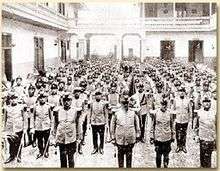Republican Guard (Peru)
The Peruvian Republican Guard (Spanish: Guardia Republicana del Perú) was a Peruvian security force responsible for border control, custody of the prisons, and guarding significant government buildings.

History
The Republican Guard originally started as an infantry regiment of the Peruvian Gendarmerie (Gendarmería Nacional del Perú) which was founded in 1852, and was transformed into the 1st Gendarme Battalion in 1862, and fought in the War of the Pacific, with headquarters at the “Sacramentos de Santa Ana” Barracks, located in the street of the same name and next to Plaza Italia, in Barrios Altos, Lima (now the campus of the "Heroes of Cenepa" Elementary School).
It would be only in 1919 when the 1st Gendarme Battalion became the 1st Gendarme Battalion "Peruvian Republican Guard", upon the recommendations of then President Augusto Bernardino Leguía Salcedo, at the suggestion of the Peruvian Army General Gerardo Alvarez, who when on a visit to Paris, France, saw the French Republican Guard and inspired by its long history and its mission to guard government institutions and the presidency made it clear that it was due time that Peru adopt its example. A Supreme Decree for this purpose was enacted on August 7 that same year.[1] With Florentino Bustamante, a former NCO, as its first commanding officer till 1923, the Guard Battalion's mandate was to ensure security in all buildings of the national government especially "the security of the Government Palace and the National Congress", as stated in the decree that raised it. It later became a full regiment.
In 1931, the Republican Guard Regiment was transformed into the 2nd Infantry Regiment of Security, in a failed effort to begin the unification of the national police services following the Chilean example. It reverted to its former name later that year by the orders of President David Samanez Ocampo, and formally reorganized once more and stripped of its State Color.
The regiment would be reformed in 1932, with a new motto: "Honor, Loyalty, Discipline", by now commanded by COL Enrique Herbozo Méndez, Peruvian Army, and after the assassination of President Luis Miguel Sánchez Cerro on April 30, 1933, stayed as the presidential guard for several more years. The reorganized Regiment's strength was a regimental headquarters unit, service battalion and 2 battalions, the latter two composed of 3 rifle companies each plus a machine gun platoon and the regimental band and Corps of drums.
In 1935 the Guard's role was expanded, through the enactment by the National Congress of the Republican Guard Organic Law, signed that same year by President Field Marshal Óscar R. Benavides, to patrolling the land frontiers, security of prisons, security of private and public places of national importance, and to assist in maintaining peace and order and national security as a whole, as well as contributing to the efforts of the armed forces during wartime.
Entrance into the Guard was voluntary and by the 1980s it numbered over 5,000 men. It was equipped with light infantry weapons, mostly carbines and submachine guns, and riot gear.
The Guard formed its own Parachute squadron in 1963. For most of its existence, the Guard recruited directly from the Peruvian Army and lacked its own training facilities, but then in 1973, it opened a Superior School for senior officer training. The Republican Guard Instruction Center was opened in 1977 and it was responsible for the training of all Guardsmen. It later absorbed the Superior School. Only in 1959 and again from 1974 onward that the Guard had its very own commanding general.
The Republican Guard became the Security Police (PS) in 1986, during the police reorganization. It continued to have responsibility for border control, custody of the prisons, and guarding significant government buildings.[2] The PS grew the most rapidly of all the police forces in the 1980s; from 6,450 in 1980 to 21,484 in 1986. Some 20 percent of the force was detailed to prison duty, with a large portion of the rest distributed among public buildings and 177 border stations. Budget difficulties have delayed the opening of more border control stations. The growing drug-trafficking problem across Peru's borders, particularly with Colombia and Brazil, provided the PS with additional challenges. The additional border posts were envisioned as one way to respond because most were proposed for areas where drug trafficking was believed to be concentrated. However, the growing prison population during the 1980s posed more difficulties for the PS; many had to do with the prisoners accused and/or convicted of terrorism.
In 1991 the Security Police became a part of the National Police of Peru in compliance with national security laws.
Issues
In December 1989, two police officers were found guilty of abuses in the prison massacre by a Court of Military Justice and were sentenced to prison terms. The other sixty-nine police members and six army officers accused were acquitted, but in June 1990 the not-guilty verdicts of eight of the police officers were overturned in a Military Appeals Court. One officer was sentenced to one month in jail, the other seven to six months.
See also
References
- Article 1 of Supreme Decree of August 7, 1919 reads: "The 1st and 2nd Gendarme Battalions have the same regimental organization of army corps, with its current budget and shall now called the " Republican Guard ", commanded by a Lieutenant Colonel, with 27 officers and 431 individuals of all ranks, divided into 2 companies of 2 battalions each, 1 machine gun company and a headquarters military band. "
- http://lcweb2.loc.gov/cgi-bin/query/r?frd/cstdy:@field%28DOCID+pe0161%29
- Armed Forces of Latin America by Adrian English, 1984, Janes's Publishing, ISBN 0-7106-0321-5
- The Military Balance, The International Institute of Strategic Studies, 1983
- A Country Study: Peru, Library of Congress 1981 and 1993